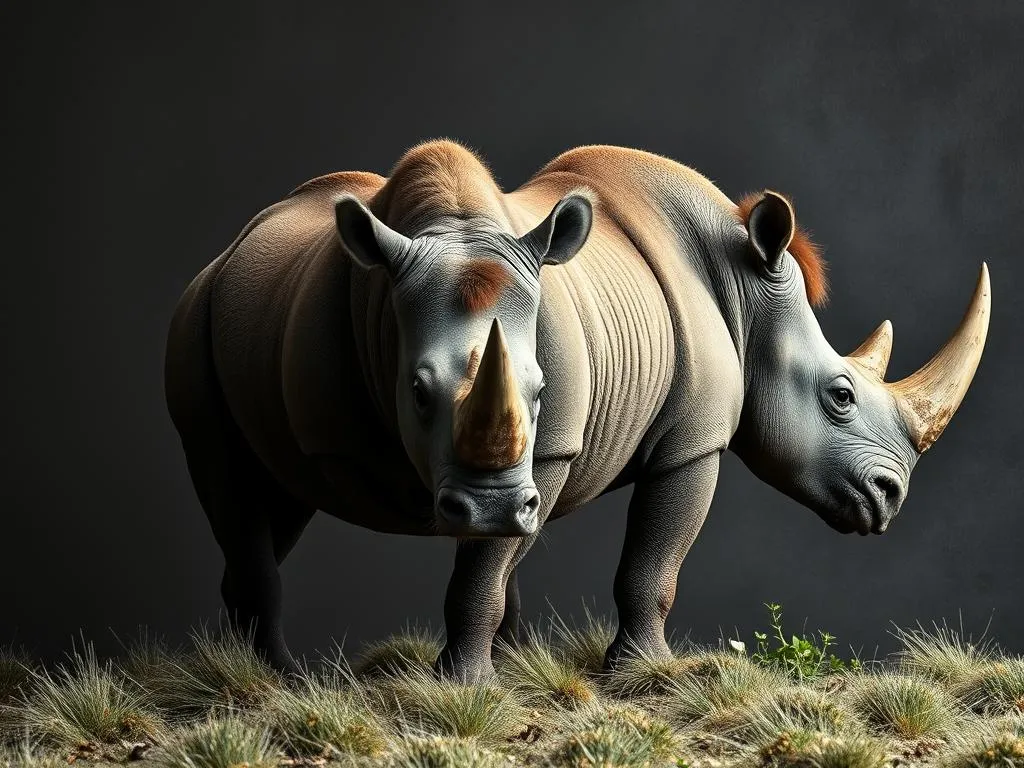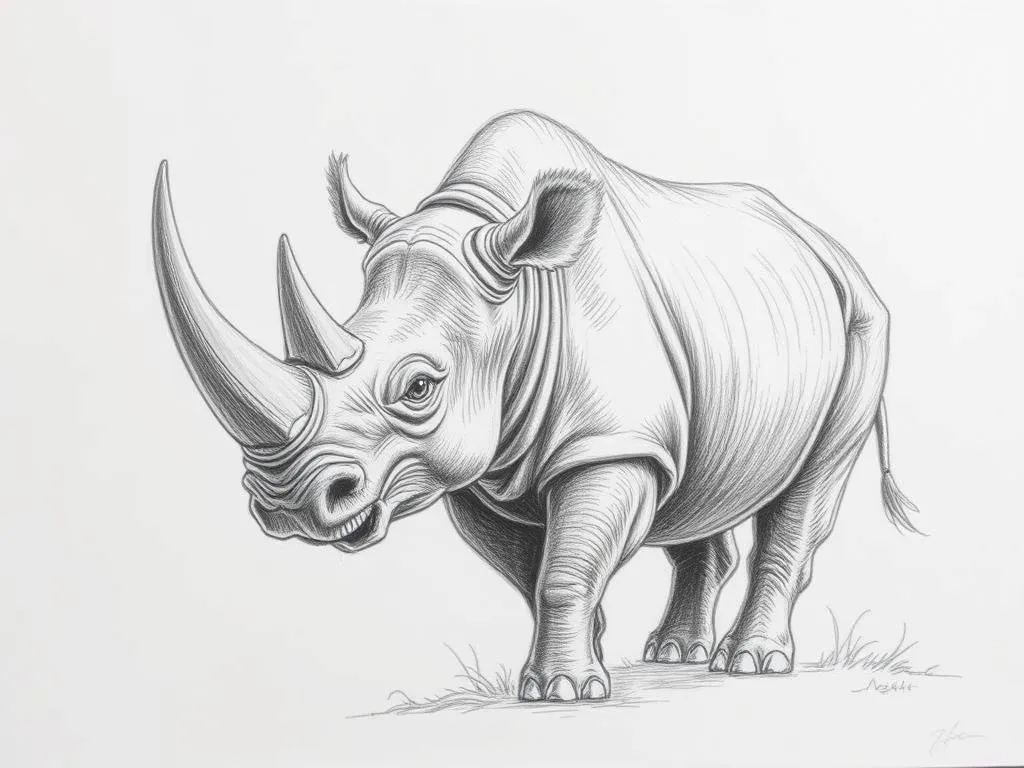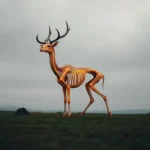The Woolly Rhinoceros: A Symbol of Strength and Resilience

Disclaimer: Some images on this website are AI-generated artworks and may not accurately represent real animals.
The woolly rhinoceros stands as an iconic figure from the prehistoric era, representing not only a fascinating chapter in Earth’s history but also rich symbolism and meaning that resonates even today. This majestic creature, with its formidable presence and unique adaptations, has captured the imagination of many cultures throughout time. In this exploration, we will delve into the various aspects of the woolly rhinoceros, from its physical characteristics to its profound symbolism and the lessons we can learn from its existence.
Understanding the Woolly Rhinoceros
Overview of the Species
The woolly rhinoceros (Coelodonta antiquitatis) was a large herbivorous mammal that roamed the tundra regions of Europe and Asia during the Pleistocene epoch. Known for its thick, shaggy coat, which provided insulation against the cold, this species was well-adapted to its frigid environment.
| Physical Characteristic | Description |
|---|---|
| Height | Up to 1.8 meters at the shoulder |
| Length | Approximately 3.5 to 4 meters |
| Weight | Between 1,000 to 3,000 kg |
| Skin | Thick and covered with a dense layer of fur |
| Horns | Two large horns made of keratin, with the front horn being the most prominent |
The woolly rhinoceros inhabited vast areas, including parts of modern-day Siberia, France, and the British Isles. Its diet primarily consisted of grasses, shrubs, and other vegetation available in the tundra. However, as the climate began to warm at the end of the last Ice Age, the woolly rhinoceros faced significant challenges, eventually leading to its extinction around 10,000 years ago.
Cultural Significance in Prehistoric Societies
In prehistoric societies, the woolly rhinoceros played a crucial role in the lives of early humans. Evidence suggests that these creatures were hunted for their meat, hides, and bones. The woolly rhinoceros provided essential resources for survival, making it a vital part of the human ecosystem.
Artistic depictions of the woolly rhinoceros can be found in numerous cave paintings and artifacts, signifying its importance in the cultural narratives of the time. These representations often showcased the creature in dynamic hunting scenes, reflecting both reverence and the relationship between humans and nature.

Symbolism and Spiritual Meaning
The woolly rhinoceros transcends its physical existence, embodying various symbolic meanings that have evolved through time.
Strength and Resilience
At its core, the woolly rhinoceros symbolizes strength and resilience. Its ability to thrive in harsh, unforgiving climates exemplifies durability in the face of adversity. This symbolism serves as a powerful reminder for individuals facing challenges in their own lives. The woolly rhinoceros teaches us to embrace our inner strength and to persevere, no matter the obstacles we encounter.
Connection to Nature
Moreover, the woolly rhinoceros signifies a profound connection to nature. As a creature that roamed the wild and untamed landscapes of prehistoric Earth, it represents the intricate balance of ecosystems. The woolly rhinoceros reminds us of the importance of respecting nature and acknowledging our role within it. This connection is crucial, especially in times of environmental crisis, as we strive to maintain ecological balance.
Ancient Wisdom
Various prehistoric cultures interpreted the woolly rhinoceros through the lens of ancient wisdom. In many mythologies, it symbolizes the power of the natural world and the lessons it imparts. From hunting rituals to spiritual beliefs, the woolly rhinoceros was often seen as a guardian or protector, embodying the primal forces of life.
The Woolly Rhinoceros in Dreams
Dreams involving the woolly rhinoceros can carry significant meaning, offering insights into our subconscious thoughts and emotions.
Common Dream Scenarios
Encounters with the woolly rhinoceros in dreams may manifest in various scenarios, including:
| Dream Scenario | Symbolism |
|---|---|
| Direct encounter with a woolly rhinoceros | Represents personal strength and courage |
| Observing the creature from a distance | Suggests feelings of protection and guidance |
| Being chased by a woolly rhinoceros | Reflects personal challenges and fears |
Interpretations of Dreaming about Woolly Rhinoceroses
When dreaming about woolly rhinoceroses, individuals may interpret these experiences as reflections of their own resilience and instincts. Often, such dreams highlight personal strengths and the ability to confront life’s challenges head-on.
Dreaming of a woolly rhinoceros can also serve as a reminder to tap into one’s inner power and to trust in one’s instincts. As these creatures symbolize survival and tenacity, they urge dreamers to embrace their own strength and to navigate through life’s complexities with confidence.
Modern Interpretations
The legacy of the woolly rhinoceros extends into modern culture, where it continues to inspire and symbolize various themes.
Cultural References Today
In literature and media, the woolly rhinoceros is often depicted as a symbol of strength and resilience. Its presence can be found in various forms of art, from illustrations in children’s books to representations in films. These portrayals serve to remind contemporary audiences of the enduring spirit of the woolly rhinoceros and its connection to the natural world.
Conservation and Awareness
In recent years, the woolly rhinoceros has emerged as a potent symbol in the conversation surrounding endangered species and wildlife conservation. As we face unprecedented challenges in preserving biodiversity, the woolly rhinoceros represents both a poignant reminder of what has been lost and a call to action for the protection of existing wildlife.
The woolly rhinoceros is often used in advocacy campaigns aimed at raising awareness about ecological issues. By focusing on this iconic creature, conservationists aim to educate the public about the importance of preserving our planet’s biodiversity and the need to protect endangered species.
Key Takeaways
The symbolism and meaning of the woolly rhinoceros offer valuable lessons applicable to modern life. Here are some key takeaways:
- Embrace strength and resilience in daily challenges.
- Foster a deeper connection with nature and recognize our role in the environment.
- Understand the importance of conservation and the need to protect endangered species.
- Reflect on the wisdom of ancient cultures and their reverence for the natural world.
- Recognize the significance of personal instincts and inner strength in navigating life’s complexities.
Conclusion
The woolly rhinoceros, with its remarkable adaptations and cultural significance, remains a powerful symbol of strength and resilience. Its legacy transcends time, reminding us of the deep connections we share with the natural world and the lessons we can learn from the past. As we continue to navigate the complexities of modern life, let us carry forward the wisdom embodied by the woolly rhinoceros, advocating for the preservation of wildlife and honoring the resilience within ourselves. Through this understanding, we can work towards a more balanced and harmonious existence with nature, ensuring that the spirit of the woolly rhinoceros lives on in our consciousness and actions.







